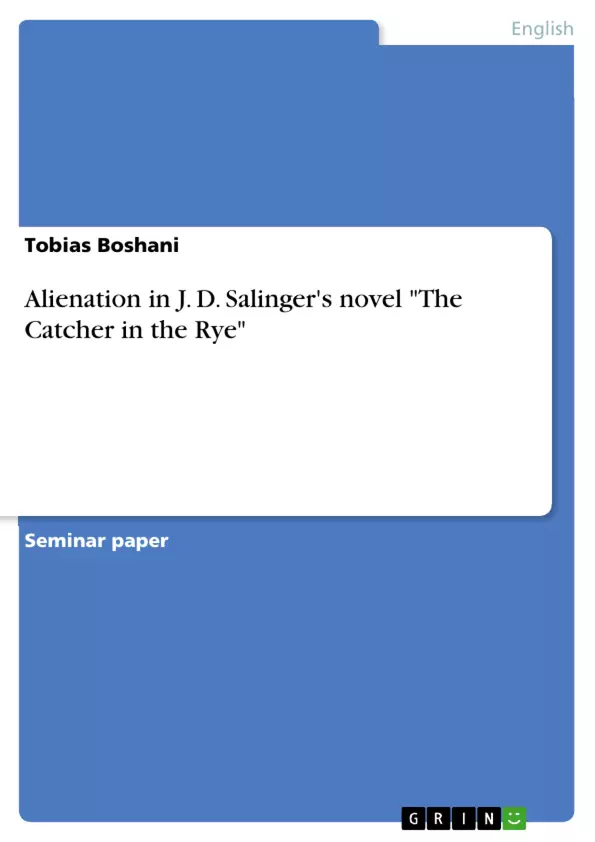This term paper wants to examine the protagonist’s behavior in "The Catcher in the Rye" and analyze where his negativity towards society is coming from. Furthermore, the author wants to prove that his isolation is the reason for his alienation, with which he thinks that he can protect himself but, in truth, prevents him from getting help.
Alienation is an essential concept in social philosophy, functioning as the key term and a diagnostic tool for the study of a social crisis that is present since the 18th century. The theory is often associated to be the main criticism of the concept of capitalism and overall describes the powerlessness and the lack of freedom of our society. Reason for that is the accompanying increasing focus on making a profit and the affection towards materialism. Both are depicted to be the trigger for the growing divisiveness between humans and the world and thus, used as an explanation for social suffering.
However, this is just one possible perspective on the term since many known social philosophers have dealt with it, which consequently ends in countless approaches on the subject matter. Moreover, it is a commonly used topic in multiple art forms and primarily known to literature. In the best known and globally famous novel "The Catcher in the Rye", by American writer J. D. Salinger, alienation plays a significant role as it represents the sixteen-year-old adolescent Holden Caulfield coming of age. In the three days that the novel depicts, the reader perceives the world through the eyes of the central character, who is also narrating the story.
Inhaltsverzeichnis (Table of Contents)
- Introduction
- Theoretical Framework
- A Relationship to The World
- Resonance defined by Hartmut Rosa
- Alienation defined by Rahel Jaeggi
- Analysis
- What are the origins of Holden's alienation?
- A Strange World
- Conclusion/Discussion
- Bibliography
Zielsetzung und Themenschwerpunkte (Objectives and Key Themes)
This paper aims to analyze the theme of alienation in J. D. Salinger's "The Catcher in the Rye" through the lens of the protagonist, Holden Caulfield. It will examine the roots of Holden's alienation, exploring his perception of society and its impact on his behavior. The paper will further argue that Holden's isolation is a key factor contributing to his alienation, hindering his ability to connect with others and seek help.
- The concept of alienation in social philosophy
- Holden Caulfield's alienation as a representation of adolescent coming-of-age
- The relationship between isolation and alienation
- The impact of societal expectations and norms on individual experience
- The role of relationships and connection in mitigating alienation
Zusammenfassung der Kapitel (Chapter Summaries)
The Introduction provides an overview of alienation as a concept in social philosophy, highlighting its relevance to the study of social crisis and its connection to capitalism. The chapter introduces Holden Caulfield as the protagonist of "The Catcher in the Rye" and establishes the focus of the paper on exploring his alienation.
The Theoretical Framework chapter outlines the key concepts that will be utilized throughout the analysis. It defines the term "relationship" from a constructivist perspective and introduces Hartmut Rosa's concept of "resonance" as a mode of being in the world. The chapter concludes by defining "alienation" through the lens of philosopher Rahel Jaeggi, emphasizing the disruption of mutual influence between subjects and their surroundings.
Schlüsselwörter (Keywords)
This paper focuses on the themes of alienation, isolation, adolescence, and coming-of-age, exploring these concepts through the lens of J. D. Salinger's "The Catcher in the Rye". The analysis utilizes theoretical frameworks from social philosophy, specifically focusing on the work of Rahel Jaeggi and Hartmut Rosa. Key terms include resonance, relationship, and the impact of social structures on individual experience.
- Arbeit zitieren
- Tobias Boshani (Autor:in), 2020, Alienation in J. D. Salinger's novel "The Catcher in the Rye", München, GRIN Verlag, https://www.hausarbeiten.de/document/911254


